You can listen to Hoosier History Live! live on the air each Saturday, or listen online at the WICR website during the broadcast on any computer with speakers, anywhere, or on a smartphone. We invite you to visit our website!
April 23 show
Kurt Vonnegut's childhood friend
They met as children and quickly became part of the same group of friends during the Great Depression in Indianapolis. Majie Failey and future literary sensation Kurt Vonnegut Jr. took dance lessons with their pals, spent summer weekends as teenagers at Lake Maxinkuckee and, while attending Shortridge High School, hung out at bygone haunts such as the North Pole drive-in and Eaton's Restaurant.
Majie and Vonnegut, a quipster (even then!) whose childhood nickname was "Kay," remained close friends until his death four years ago this month (April 2007) at age 84. He even told Majie - and several other people - that the major character in his play Happy Birthday, Wanda June (1970) was based on her father.
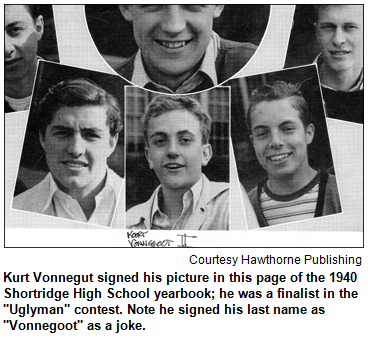 Now Majie, who became society editor of The Indianapolis News in the late 1940s, has written We Never Danced Cheek to Cheek (Hawthorne Publishing), an anecdote-filled book about her famous chum. Its title is derived from a note Vonnegut scribbled to her atop the sketch of one of his self-portraits, referring to the fact that, despite their friendship of nearly 75 years, the two never dated.
Now Majie, who became society editor of The Indianapolis News in the late 1940s, has written We Never Danced Cheek to Cheek (Hawthorne Publishing), an anecdote-filled book about her famous chum. Its title is derived from a note Vonnegut scribbled to her atop the sketch of one of his self-portraits, referring to the fact that, despite their friendship of nearly 75 years, the two never dated.
Majie - who eventually married Skip Failey, another Vonnegut crony - will join Nelson in studio to share insights about the Pulitzer Prize-winning author of bestsellers such as Slaughterhouse-Five (1969) and Palm Sunday (1981). Majie writes that Vonnegut often told her he was "happier at Shortridge than anywhere else in his whole life."
His adult life included his capture during World War II by the Germans (as a POW, he witnessed the bombing of Dresden); the sudden death of his mother (Majie writes that she agrees with Vonnegut family members who dispute Kurt's conclusion it was a suicide), and the death of Kurt's beloved sister, Alice, from cancer. 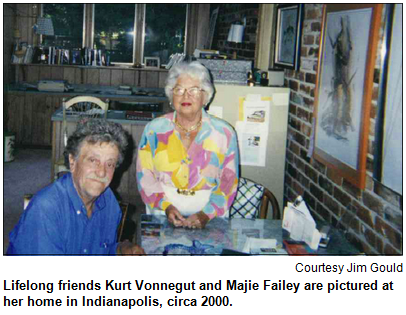 Tragically, Alice's husband was killed in a train accident within days of her death; Kurt promptly adopted her young, orphaned sons.
Tragically, Alice's husband was killed in a train accident within days of her death; Kurt promptly adopted her young, orphaned sons.
He raised them - as well as his three oldest children - with his first wife, Jane Cox Vonnegut, who was Majie's best friend as a young girl at Tudor Hall in Indianapolis. Subsequently, Majie persuaded her parents to let her attend Shortridge, where Vonnegut (class of '40) served as an editor of the legendary Echo, the country's first daily newspaper at a high school. We Never Danced Cheek to Cheek includes photos from yearbooks at Shortridge, where Kurt was a finalist in the "Uglyman" contest - which, despite its title, actually was a popularity contest.
"Trust me, Kurt was not ugly," Majie writes. "Girls wanted a date with him. ... As for Kurt's zany sense of humor, he was to all of us the prince of laughs. ... Kurt Vonnegut spoofed life while he was still trying to understand it."
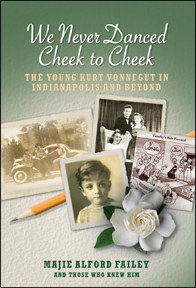 She notes that the two of them made for a "Mutt and Jeff" pairing, with Vonnegut eventually standing 6-feet-3 and tiny Majie barely 5 feet tall. Referring to Vonnegut's note about not dancing cheek-to-cheek, Majie writes, "I could not have reached his cheek, much less his vest buttons."
She notes that the two of them made for a "Mutt and Jeff" pairing, with Vonnegut eventually standing 6-feet-3 and tiny Majie barely 5 feet tall. Referring to Vonnegut's note about not dancing cheek-to-cheek, Majie writes, "I could not have reached his cheek, much less his vest buttons."
In her book, Majie also shares insights about the Vonnegut family's reversal of fortune during the Great Depression; Kurt Sr., an architect, was unable to secure commissions because business and residential construction halted. Because her close friendship with Vonnegut continued for so long - the Faileys were Kurt and Jane's house guests on the East Coast before and during the period he became a literary sensation in the late 1960s - Nelson has much to explore with her during our show.
Even during Vonnegut's final return visits to Indianapolis, he invariably settled on the leather sofa on the sun porch of Majie's home. That's where he often revised the memorable speeches he would deliver to Hoosier audiences.
Some notes:
- Like Kurt, Majie also adored his older sister Alice, who apparently lit up rooms with her effervescence. "All of us in the childhood gang were in awe of Alice," Majie writes.
- We Never Danced Cheek to Cheek includes observations about Kurt Vonnegut from others who were acquainted with him. They include Nelson, who interviewed him periodically.
- Vonnegut fans are invited to a reception and book signing with Majie from 5:30 to 7:30 p.m. on May 5 at the Athenaeum, the Indianapolis landmark designed in 1894 by his grandfather, distinguished architect Bernard Vonnegut.
- Her book is dedicated to yet another generation of Vonneguts: Kurt's son Mark and daughters Edie and Nanette, who also have been Majie's lifelong friends.
Roadtrip: Redbud Trail Rendezvous near Rochester
 Chris Gahl of the ICVA tells us to head up north along U.S. 31 to Fulton County in the north central part of Indiana, an area also known for its abundance of round barns, and check out the Redbud Trail Rendezvous festival the weekend of April 30 and May 1.
Chris Gahl of the ICVA tells us to head up north along U.S. 31 to Fulton County in the north central part of Indiana, an area also known for its abundance of round barns, and check out the Redbud Trail Rendezvous festival the weekend of April 30 and May 1.
The festival is named for the redbud trees along the Tippecanoe River, and it features historical re-enactors from a number of different periods of frontier Indiana, including western fur trade, French and Indian War and Revolutionary War. You'll also find cooking over open fires, music and dancing, and demonstrations of muzzle-loading rifles. The festival is $3 for adults but also includes free admission to the Fulton County Historical Museum for a look at that round barn.
While you're in the area, the Chief Menominee Memorial is right off the road near Plymouth; lest we forget that the infamous Potawatomi Trail of Death started out from this area in 1838.
History Mystery question
Among the landmark buildings designed by prominent Indianapolis architect Bernard Vonnegut, the grandfather of Kurt Vonnegut Jr., was the flagship L.S. Ayres department store. 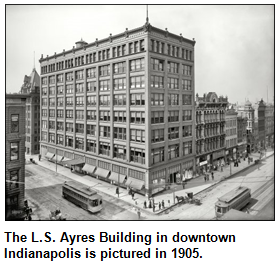 It opened in 1905 at the corner of Meridian and Washington streets. However, one feature of the department store building was not designed until about 30 years later. In the mid-1930s, Bernard's son, Kurt Sr., designed this feature of the Ayres building.
It opened in 1905 at the corner of Meridian and Washington streets. However, one feature of the department store building was not designed until about 30 years later. In the mid-1930s, Bernard's son, Kurt Sr., designed this feature of the Ayres building.
Question: What was it?
To win the prize, you must call in with the correct answer during the live show. The call-in number is (317) 788-3314, and please do not call until you hear Nelson pose the question on the air. Please do not call if you have won a prize from any WICR show during the last two months. The prize is two tickets to the premiere of If These Walls Could Tell, presented by Storytelling Arts of Indiana on Friday, April 29, at 7:30 p.m. at the new Indiana Landmarks Center. The inaugural performance, Hugged by These Walls, told by Sally Perkins, brings to life the people who made the Central Avenue Methodist Church, once the largest Methodist congregation in the state, a powerful contributor to the creation of the capital city. Tickets are courtesy of Indiana Landmarks.
Your Hoosier History Live! team,
Nelson Price, host and creative director
Molly Head, producer, (317) 927-9101
Chris Gahl, Roadtripper
Richard Sullivan, webmaster and tech director
Pam Fraizer, graphic designer
Garry Chilluffo, creative consultant
Michele Goodrich, Jed Duvall, grant consultants
www.hoosierhistorylive.org




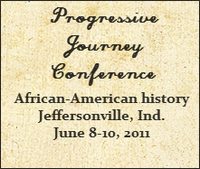
Please tell our sponsors that you appreciate their support: A Progressive Journey through Indiana History, Indiana Historical Society, Kurt Vonnegut Memorial Library, Lucas Oil and Story Inn.
 Acknowledgments to Print Resources, Indianapolis Marion County Public Library, Monomedia, Indiana Humanities, Indianapolis Convention & Visitors Association, WICR-FM, Fraizer Designs, Chelsea Niccum and many other individuals and organizations. We are an independently produced program and are self-supporting through organizational sponsorships, grants and through individual tax-deductible contributions through the Indiana Humanities Council. Visit our website to learn how you can support us financially.
Acknowledgments to Print Resources, Indianapolis Marion County Public Library, Monomedia, Indiana Humanities, Indianapolis Convention & Visitors Association, WICR-FM, Fraizer Designs, Chelsea Niccum and many other individuals and organizations. We are an independently produced program and are self-supporting through organizational sponsorships, grants and through individual tax-deductible contributions through the Indiana Humanities Council. Visit our website to learn how you can support us financially.
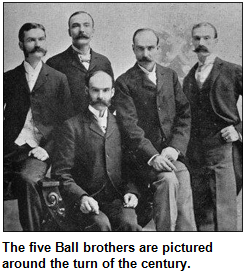 In the news ...
In the news ...
Nelson is interviewed for Ball Brothers story in Investor's Business Daily
Nelson was recently interviewed by colleague Victor Reklaitis in the national daily business newspaper Investor's Business Daily in a story about the five Ball Brothers from Muncie. According to the article, the five brothers "manufactured can-do spirit in a jar."
In the article, Nelson says that Frank, one of the five brothers, would display his missing index figure when giving a speech. He had lost the finger in an accident but used that to his advantage when rousing a crowd. Certainly no one has more knowledge of Indiana anomalies than Nelson!
April 30 show - encore presentation
Your house has a history
If only your walls could talk, right? This is the ideal show for folks wondering how to track down the past "lives" of their houses. Nelson is joined in studio by two Indianapolis-based home history hunters who live in historic houses themselves and who know firsthand the challenges involved and resources available.
 With tips and advice galore, photo historian Joan Hostetler, owner of Heritage Photo & Research Services, and Tiffany Benedict Berkson, the "Home History Hunter," will offer guidance about how to get started, as well as the pitfalls to avoid.
With tips and advice galore, photo historian Joan Hostetler, owner of Heritage Photo & Research Services, and Tiffany Benedict Berkson, the "Home History Hunter," will offer guidance about how to get started, as well as the pitfalls to avoid.
The two house history "detectives" offer advice to help you:
- Identify sources in local libraries (including city directories) and online help for unearthing your home's history.
- Explore the challenges and curves you may encounter. For example, some streets in Indy were renamed years ago. Did you know a portion of East 10th Street once was known as Clifford Street? In addition, many residential addresses across town were changed as the city grew.
- Offer guidance on using Sanborn maps, the Indiana State Library, the Indiana Historical Society and U.S. Census info as resources.
- Share some special tips. "Did you know that the family most likely to have good photographs of your home lived across the street?" Joan says. "They usually positioned their children or family by the street and took a snapshot from the porch."
Joan is the owner of Heritage Photo & Research Services, which specializes in photographic preservation, archive management, digital imaging and photographic research. She lives and works in a home built in 1888 in the Cottage Home neighborhood by the legendary architectural firm of Vonnegut & Bohn. Active in neighborhood revitalization efforts, Joan collaborated with Nelson and photographer Garry Chilluffo on the Indianapolis Then and Now (Thunder Bay Press) visual history book.
Tiffany lives in a spacious, turreted Victorian house built in 1897 in Herron-Morton Place, where she is a past president of the neighborhood association.  An avid local history enthusiast with a particular interest in the Victorian era, she is a member of the Daughters of the American Revolution (Caroline Scott Harrison chapter) and a former volunteer at the President Benjamin Harrison Home.
An avid local history enthusiast with a particular interest in the Victorian era, she is a member of the Daughters of the American Revolution (Caroline Scott Harrison chapter) and a former volunteer at the President Benjamin Harrison Home.
The following "learn more" websites are recommended by our guests:
Also new is Your Historic Indianapolis, an interactive forum where people can post questions about an address or family; it will hopefully be a resource for those willing to explore or share their knowledge of Indianapolis.
This show is an encore broadcast of a popular program in our Hoosier History Live! archives. (The original live broadcast date was May 29, 2010.) So there won't be an opportunity for call-in questions from listeners. But that opportunity will return on May 7 with a brand-new Hoosier History Live! show, as well as the e-newsletter, which will return on May 6.
© 2011 Hoosier History Live! All rights reserved.